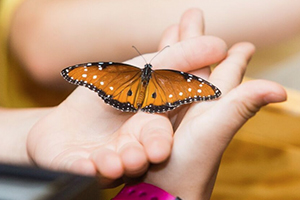Sonoran Desert Natural Events Calendar — Winter
Roseann Beggy Hanson & Jonathan Hanson
December, January, early February
December
Average high: 65°F (18.3°C)
Average low: 39°F (3.9°C)
Relative humidity at 5 am: 61%
Relative humidity at 5 pm: 34%
Normal rainfall: .94" (23.9mm)
December is a mild month, with mostly cool but sunny days and only a few nights dropping below freezing, and possibly a few days of light winter rains.
- Flora
-
Fruits of desert mistletoe, Christmas cactus, and netleaf hackberry trees are ripening, providing food for many birds and mammals. If winter rains begin, many shrubs such as brittlebush, creosote, and ocotillos will sprout bright new leaves, but many trees, such as mesquites, palo verdes, and sycamores, will drop their leaves as the temperatures dip below freezing.
- Fauna
-
Birds in the Mimic-Thrush family, such as mockingbirds and curve-billed thrashers, begin to establish mating territories. They “map”territories by singing their famous copycat songs from the tops of trees, poles, or fences. Cactus wrens begin to build their breeding nests; they also build separate roosting nests—some pairs will build three or more nests. Anna’s hummingbirds may also breed this month. The males can be heard singing their squeaky songs around feeders.
- Nature Watching Tips for December
-
Tohono Chul Park, in northwest Tucson at the corner of Oracle and Ina roads, is a great place to watch cactus wrens building nests in cholla cacti. For information on the park, call (520) 575-8468.

January
Average high: 64°F (17.8°C)
Average low: 38°F (3.3°C)
Relative humidity at 5 am: 62%
Relative humidity at 5 pm: 32%
Normal rainfall: .86" (21.8mm)
Normal snowfall: .31" (7.9mm)
In January, deserts will experience freezing temperatures half a dozen times, while up in the mountains it will freeze nearly every night and a foot of snow may fall. Desert days are mostly clear and pleasant, ranging from cool to warm; sometimes cold rains will arrive from the northwest.
- Flora
-
At lower elevations, Frémont cottonwoods begin to sprout new leaves and open blossoms. If rain has been falling, many annuals and grasses will be sprouting new green growth.
- Fauna
-
Mockingbirds, curve-billed thrashers, cactus wrens, and packrats (white-throated woodrats) begin their breeding seasons. Male phainopeplas—glossy black crested birds with white wing patches—perch conspicuously in palo verde or mesquite trees that are well-endowed with desert mistletoe berries, an important food source. They perform fluttery flight-displays to attract females. Mule deer breeding season, called the “rut,”is in full swing. Males engage in violent-looking but seldom injurious sparring with their antlers. Mountain lions feed well this month in the mountain foothills, where distracted male deer make easier prey.
- Nature Watching Tips for January
-
Dozens of phainopeplas usually make a great show in tall palo verde and mesquite trees along Highway 286, about ten miles (16 km) south of Three Points (Robles Junction).

February
Average high: 67.5°F (19.7°C)
Average low: 40.2°F (4.6°C)
Relative humidity at 5 am: 59%
Relative humidity at 5 pm: 27%
Normal rainfall: .63" (16.0mm)
Winter is loosening its grip on the deserts; only a couple of nights may dip below freezing. Warm days tempt us later in the month with thoughts of spring—days in the 80s are possible—but cold snaps are still more probable.
- Flora
-
Blooming shrubs may include chuparosa, samota, and desert mock-orange. Later in the month, if the fall and winter rains were generous, desert wildflowers may begin their show with such species as Mexican gold poppies, lupines, and owl-clover. In mountain canyons, deciduous trees such as alders and walnuts may bloom before they send out new leaves.
- Fauna
-
Costa’s hummingbirds join Anna’s hummingbirds in establishing breeding territories around backyard feeders or blooming chuparosa shrubs. Male Costa’s hummingbirds display for females and mark their territories with a distinctive “zing” call. Rust-colored hummers that show up at feeders around mid-month are rufous hummingbirds, which are migrating through the Southwest. Gila woodpeckers hammer away at tree trunks or even metal pipes around buildings; they are marking their territories using sound. In the cool evenings or pre-dawn mornings, great horned owls can be heard calling softly, usually in duos, as they begin their breeding season. Pipevine swallowtail butterflies are common fliers this month.
- Nature Watching Tips for February
-
Early wildflowers begin to bloom in Organ Pipe Cactus National Monument; especially beautiful is the elusive ajo lily. For information call (520) 387-6849. For early blooms around Tucson, explore the south-facing rocky slopes of the Tucson Mountains, in Tucson Mountain Park, or Saguaro National Park, especially near the Desert Museum. Popular February and March wildflower viewing areas include Picacho Peak State Park, Pinal Pioneer Parkway between Oracle Junction and Florence, Catalina State Park northwest of Tucson, and the Arivaca-Ruby loop road off I-19 (note: Ruby Road is rough but usually passable for low-clearance cars). Phoenix area hot spots include Bartlett Lake, Echo Canyon, the Desert Botanical Garden, Usury Mountain Park, and South Mountain Park.











